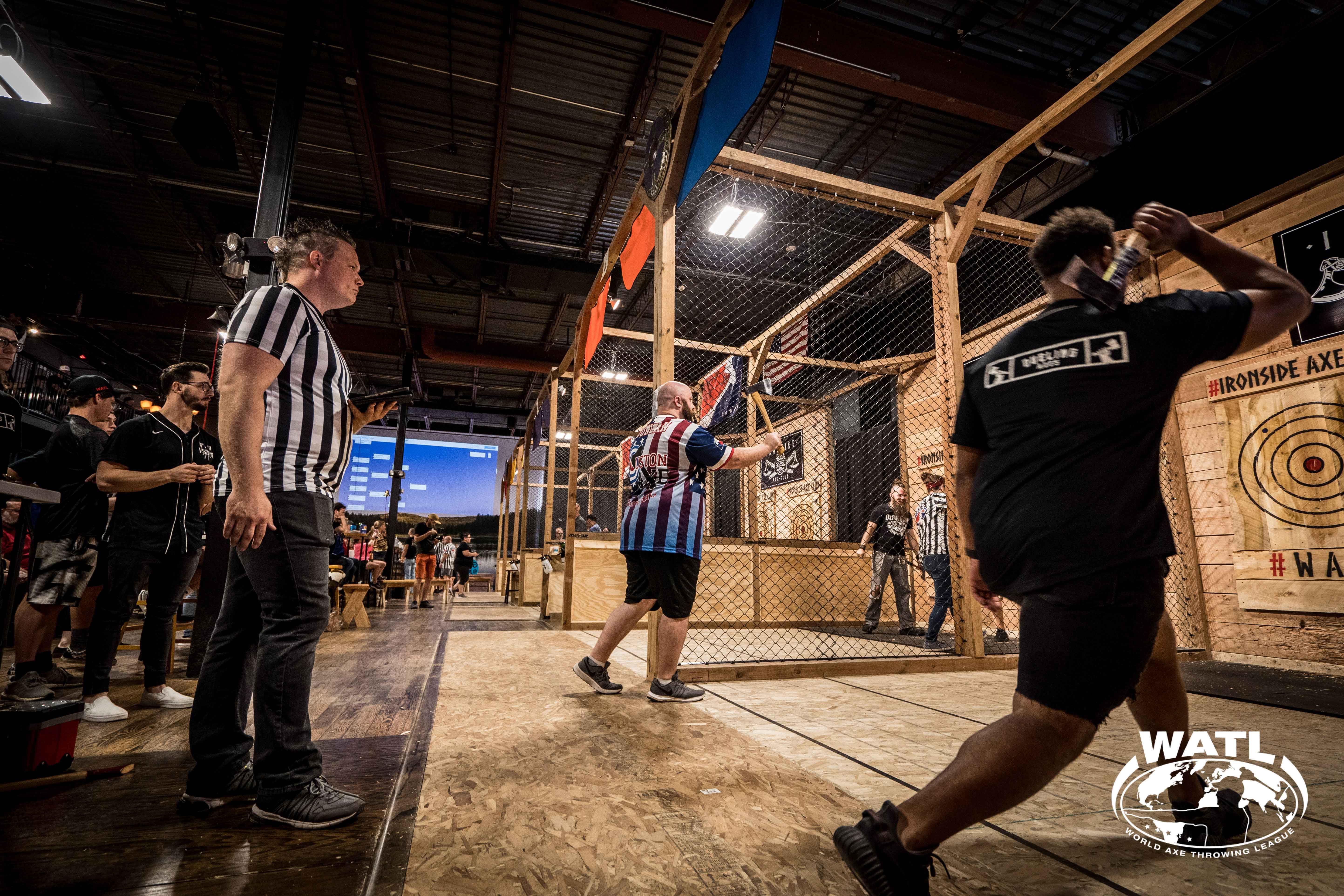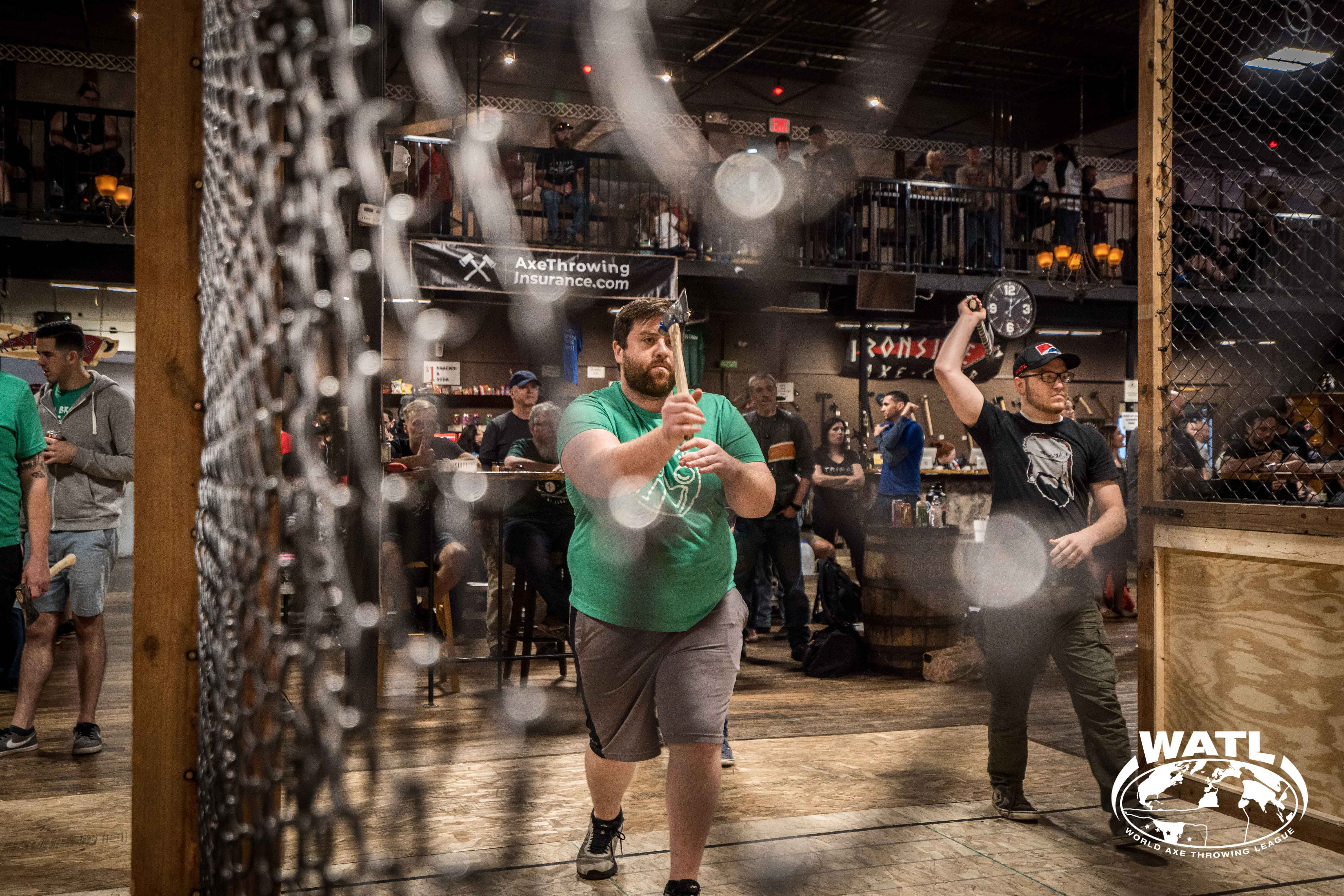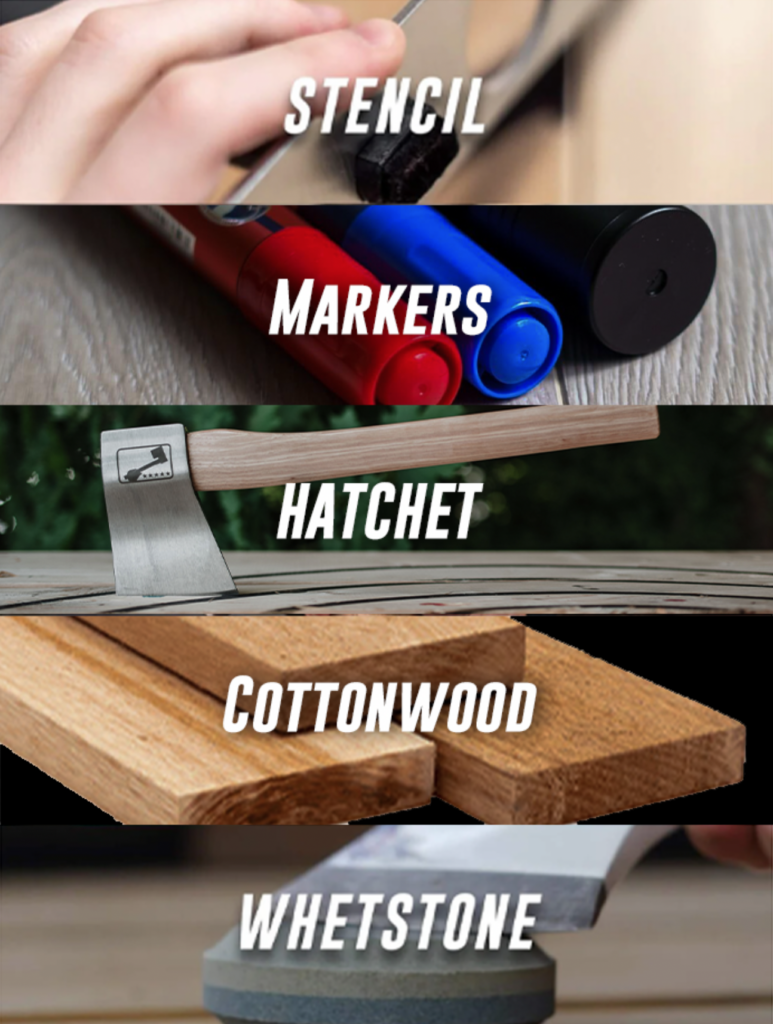Today’s guest author Ryan Smit gives us a detailed guide of how to get better at axe throwing.
Most axe throwers know, as author Jerry Gilbert in his Advanced Thrown Weapons study states, “There is no one correct way to throw”. You can learn to throw in any way you like if work on it. However, he also says that although there is no right way or wrong way, there are going to be better ways or worse ways. I would not tell someone their throw is bad if it is correctly striking the board. There are throws that take an extreme amount of time and work to perfect. There are also throws that yield relatively high accuracy with only a moderate amount of practice. Everyone has a different physiology and no two throws will ever be the same.
How To Get Better At Axe Throwing Guide
This guide is not intended to suggest a thrower change their throw entirely, but to provide tips for accuracy that can be applied to almost any throw. These are all applicable to one-handed throws with some tips for two-handed throwers. I would strongly advise any beginning or intermediate thrower to consider these points, in the journey towards a perfect throw. Remember also, abandoning old ways and being willing to change your throw has the potential of advancing your accuracy quickly.
If during your practicing you miss your intended target point at any time, down to the millimeter, there is always a reason for it. If you don’t know why you missed the target point, it will be hard to correct the error to overcome it. Throwing an axe at the target without changing your way of thinking when you miss, will likely continue to yield the same inaccuracy. This guide is a starting point for correcting this. Changing your throw and achieving higher accuracy may not feel natural to begin. Eventually, it should seem as natural as the old way!
-
SOLID STANCE
- Whether positioning to step forward, or keeping feet planted the entire duration of your throw, any footing should be solid, stable, and balanced.
- Moving your entire body. Head, feet, arm, hand, and axe, directly toward the center of the target during your throw can significantly reduce your margin of error. An unsure stance starting out can mean correcting your balance when you begin your throwing motions. This will decrease your ability to move precisely toward the target.
- Know your starting distance. Ideally, your release will be with your feet as close to the 12 foot line as possible. In a perfect world the axe striking the board with a flat blade or nearly flat blade for maximum coverage is best.
- Working on having a final position right at the 12 foot line will present an obvious advantage. There is an 8.3% larger angle for your throw trajectory to result in a bullseye if you are 12 feet away instead of 13 feet away.
-
THE GRIP ON YOUR AXE CAN MAKE ALL THE DIFFERENCE
- An inconsistent grip has a good potential for incorrect release point. This can introduce large margins of error, usually vertically. It can also make it more difficult to control spin speed, tilt left to right, and wobble.
- The most used grip by the top throwers is a lighter grip, toward the mid to end of the palm. For very fast throwers a stronger grip is usually unavoidable. Although there are examples of accurate fast throwers, strongly consider trying a more finessed throw if accuracy is your goal. There are many televised examples of great grips, though some can take practice and nuanced explanation from a more experienced thrower to understand. This very much applies to “flick” grips.
- If you’re having trouble with vertical inaccuracy in your throw and you are gripping the axe like a hammer, there are a few likely reasons.
- Stronger, full hand wraparound grips can be highly influenced by the release point.
- The release point becomes more dependent on the strength of the throw, the moisture of your hand(s) and the conscious release of your hand instead of releasing by feel.
- A light grip that almost releases itself is more ideal, and more forgiving for slight errors. This takes practice and experimentation to find but can quickly surpass the accuracy of a strong grip.
-
KEEP IT SIMPLE
- Keep your throw simple and easily repeatable. Any extra or complex motions will lead to far greater variance in throws.
- You may find during experimentation and practice, as I did, a throw that is accurate but involves movement too complex to correctly reproduce under pressure.
- In one of my situations for example, I found that by rocking slightly back and forth in line with the target while bringing up my axe to its initial position, then immediately continuing the motion without pause for the backswing and throw produced surprisingly accurate throws in quick repetition practice.
- It easily produced any number of bullseyes, and around 80% on killshots and also gave a bit more power to the throw. However because this throw used the rocking and required maintaining great balance for practice, it did not translate well into environments where nerves were involved. The greater complexity was too hard to execute with only 5 practice throws. It ended up hitting inconsistent spots inside the bullseye and resulting in 10% more missed bullseyes than the simple static stance before throwing motion did during league games.

-
HAVE A CONSISTENT STARTING POINT OF THE AXE FOR YOUR THROW SETUP
- Throw arc is the final path of your axe once it leaves your hand and travels to the target. We will assume this throw arc is from the intended release point to the center of the target. Ideally, during your setup you should have the axe already directly in line with this throw arc. Your throw arc is NOT necessarily lined up with your eyes. With a two-handed throw, you likely throw directly centered overhead, which is a throw arc centered directly between your eyes!
- If you are unwilling to change the axe’s starting position, the side motion can still be mitigated by slowing down the backswing and/or pausing briefly at the back end of the throw.
- Left to right accuracy is far more important than vertical. This is because although the targets are circles, your axe landing a millimeter outside of it left or right is a miss. Vertically you have the entire length of the blade that can be in the bullseye.
-
CHOOSE YOUR AXE, HANDLE SHAPE, AND HANDLE LENGTH MINDFULLY
- Experiment with different axes, and be open to change!
- Thin handles with flat edges or a round handle with slightly flattened edges on the sides can make it easier to grip consistently the same way and reduce the possibility of an accidentally rotated grip. The handle shape and length are however, dependent on hand size and physiology.
- A heavier axe has more inertia to sink deeper, but any axe inside the weight limits will stick consistently.
- You’ll notice that it is far easier to throw and practice for longer when using a lighter axe. Practice being critical to improving accuracy, consider a change to a lighter axe, especially for one-handed throws.
-
ADJUST TO YOUR CONDITIONS
- Know the board you’re throwing on. It boils down to how difficult it is to stick the axe without a drop. Factors tying into this are how moist the wood is, the hardness of the wood, the cut of the wood (including the angle of the grain), knots near your target point and if the wood has already been thrown on.
- If the board is very soft and everything sticks, adjusting the rotation to strike with the blade flat and parallel to the board is ideal.
- If you know the wood is hard based on any of these factors, to minimize the chance of a drop you may want to adjust the rotation of your axe more to the tip. This doesn’t necessarily always mean a huge angle adjustment. Even a 15-30 degree angle when the axe hits the board will result in the tip hitting first and likely sticking while covering additional board area with the rest of the blade.
- The ideal way to adjust rotation is by changing your throw distance from the target. Changing your grip or throw can change too many variables, where distance changes only one.

-
PICK A VERY SMALL POINT ON THE INTENDED TARGET
- Do not look away, move directly away from your target point for a backswing motion, and directly towards it during the throwing motion. This is one part of the throw you can and should actively think about during the throw.
- Drawing a small dot in practice may help, most range targets have a center dot where the stencil was anchored.
-
RELAX ARMS AND SHOULDER(S) IN YOUR THROW SETUP
- If your shoulder has a particular tension for your throw setup, it has to always be that tense every time for consistency and accuracy. It is easier for most to simply relax the shoulder(s) for the setup before the throw movements. It is easy to tense up your shoulder or shrug inadvertently before you even start your throw. Flaring your elbow can also skew your throw, making an accurate throw more difficult and possibly striking the target at an angle which may result in a drop.
-
BRING YOUR AXE BACK AND FORWARD IN LINE WITH THE TARGET AT ALL TIMES DURING THE THROW
- The back movement is almost as important as the forward throw movement in controlling the left and right accuracy of the axe because it will carry through. Practice thinking about bringing your axe straight back from the target on your backswing.
- If stepping or using your body at all for the backswing and follow-through, it is important to move directly towards the precise target point without looking elsewhere and possibly losing focus.
- Try going through the motions of your throw in front of a mirror, moving in a perfect line backwards and forward. This can be eye-opening if you had any large side movements during your throw. Standing 6 feet from a mirror gives your eyes the perspective the target has from 12 feet away.
-
BE AWARE OF THROWING TOO HARD
- Hard throws can be accurate to a point but can be incredibly difficult to progress to greater precision. Additionally, the deeper an axe sinks into the board, the lower the surface area on the side of the axe available for scoring becomes.
- It could be theorized that a harder throw resulting in less drops was the key to a higher score. However, I progressed to a much higher average by throwing with light to medium strength and refining the throw itself.
-
TAKE A DEEP BREATH BEFORE EACH THROW
- The status of your breath during your throw may vary from person to person, but taking a deep breath before each throw will help establish the same breathing for each throw.

-
IT IS NOT RECOMMENDED TO JUDGE YOUR OWN THROW OR MAKE DECISIONS ABOUT IT UNTIL YOU ARE WARMED UP
- In a league match or tournament be very wary of making changes in your throw, especially based on a one-off miss unless you know exactly what you did wrong and are just returning to your correct throw. You should practice this way as well. Get used to recognizing errors that a slip of the mind or rushing may have caused.
- Inaccuracies in practice due to initial stiffness could make you incorrectly judge the culprit of a problem and change an otherwise beneficial part of your throw. For me, this is about 15-30 throws after not throwing for half a day or more. If you’re sore it can be even more than that. If you miss the target during that time, unless you know you obviously did something wrong, it’s not a big deal and not worthy of overthinking at all.
-
KEEP YOUR AXE SHARP
- Many people use different sanders, stones, or handheld knife-edge sharpeners, and although that will suffice for an edge, moving up to extremely high grit polishing bits, polishing compounds, and honing will yield an edge that can shave. Look up or ask professionals for the best techniques or find one that works best for you! A shaving edge is ideal though.
- Thinning your axe can result in a more consistent stick in the wood for almost all throw types. This can be accomplished many ways with different types of tools. Rarely does an axe off the shelf present an ideal profile for throwing, as only a few axes on the market are sold with throwing as their intended purpose.
-
BE AWARE OF TWISTING DURING YOUR THROW
- This comes into play more with cross body baseball-type throws, and is why they are considered less accurate by nature. A cross-body throw can inherently move the axe in two different directions before release, horizontal and vertical, as your torso twists. This makes it more difficult to achieve consistency or control.
-
FOLLOW THROUGH
- The reason this makes a difference is that without fully continuing the forward motion after the release, and instead thinking about ending the throw, you may inadvertently abbreviate some or any of your motions before the axe leaves your hand(s).
- You could let go early and throw high, introduce too much spin and over-rotate, stop your arm early which can throw the axe off left or right, power reduction resulting in a drop, or drop your arm early and throw low.
- The reason this makes a difference is that without fully continuing the forward motion after the release, and instead thinking about ending the throw, you may inadvertently abbreviate some or any of your motions before the axe leaves your hand(s).
-
WRITE IT DOWN
- I highly recommend writing down a detailed description of your throw after a practice session where you had a change in your mentality or an improvement in any aspect of your throw. This way, you can review it before your next practice and not lose any revelations or marked improvements, saving time and improving your throw faster.
- If someone gave you suggestions, a thought comes to mind, or you noticed an accurate thrower doing something you want to try, write it down as well so you don’t forget.
- Eventually, once you have an aspect of your throw locked in and you keep practising the same way it becomes muscle memory. The goal is to make your entire throw muscle memory. Then, if the throw is off, your mind can be dedicated to analyzing what was done incorrectly to make the next throw perfect, rather than remembering your entire throw process.
- Recording video of your throw may reveal issues you needed the perspective to see. However your mental state can’t be caught on video so don’t rely on video only. Detailed voice notes on a phone of throw nuances as well as written notes can also be very helpful.
-
CONSISTENCY
- For all aspects of your throw, consistency is extremely important.
- A league game or tournament is not the time to try new things.
- If for instance, you don’t grip the same way each throw and you’re missing the bullseye, it can mask another factor that is also throwing you off. By paying attention and using the same grip each time, even if it is not perfect, can theoretically be removed in the process of elimination to figure out why you suddenly start missing.
- All around consistency also allows you to experiment with single aspects of your throw to discover more accurate methods. Knowing that another aspect of your throw isn’t affecting the results. The position of a single finger could be the difference between hitting bullseyes and endless frustration.
- It may happen very quickly that a small change will produce drastically more accurate results. If this does happen, write it down or record it somehow, then continue to practice it. Ensuring that one thing is the only thing that changed. If you don’t keep tabs on a beneficial change, you may actually go back not get it right the next day and waste time finding it again!
- If your axe hits anywhere other than where you aimed it at any time without an external reason or nerves, then you have room to improve and change something to be more consistent.
GET BETTER AT AXE THROWING IN LEAGUE/TOURNAMENT MATCHES
There are a few things that can throw your accuracy off during league or tournament matches, here’s how to combat them.
Those butterflies you feel when you first walk up to throw, the slight shakiness and racing heart in those first few throws can definitely affect your accuracy. The more official matches or tournaments you play in, the more you will get used to it. Luckily, there are ways of combating either the feeling itself or the effect it has on your throw. These have been invaluable to me, and are extremely important in excelling under pressure.
If you want to be in this place when you need to perform under pressure in a match, there is no better book to read than The Mindful Athlete by George Mumford. Long story short, George Mumford taught mindfulness to Michael Jordan and his team, and a surprising number of the best athletes in history. He describes proven techniques for getting into “The Zone” and stopping performance anxiety, as well as very effective guidance for practicing purposefully.
If you don’t want to read the book then I’ll just say that staying in the moment, only thinking about the target in front of you, and not letting your mind wander will give you a solid edge. Having the feeling inside you, recognizing it and disregarding it. Staying in the moment and thinking of nothing else but your task at hand, can smoothly power you through it until you’re performing at your best with low or no anxiety for the rest of the match.
Looking to Get Started in Axe Throwing? Try the Ultimate Starter Kit!
The ultimate starter kit has everything you need to kick off your axe-throwing journey right in your backyard. This comprehensive kit includes your choice of a high-quality hatchet, ensuring a personalized fit for your throwing style. To keep your blade sharp and ready, a whetstone is also included. For setting up your target, the kit features three durable cottonwood boards, a target stencil for precision marking, and target markers to help you track your progress. Perfect for beginners and enthusiasts alike, this all-in-one set makes it easy to start honing your skills and enjoying the thrill of axe throwing from the comfort of home.

Get Exclusive Offers & Stay Up-To-Date
Sign-up today and never miss an update in the exciting world of axe throwing.